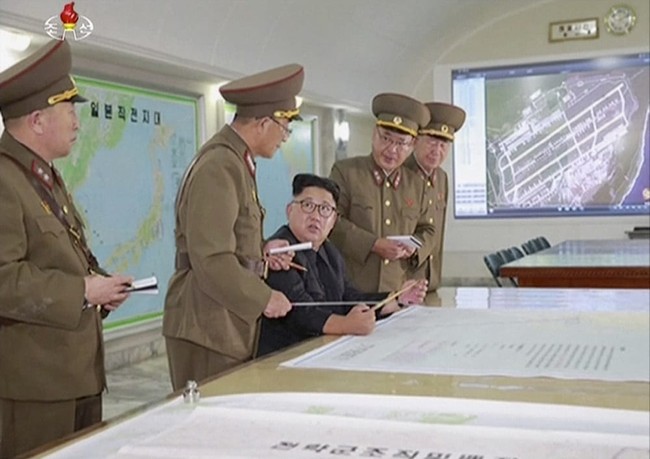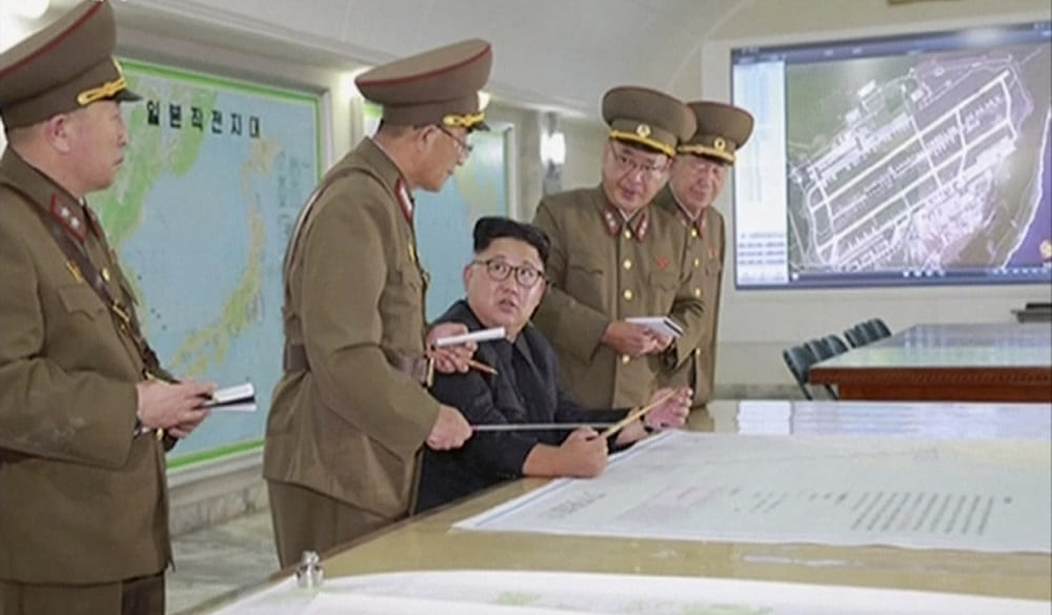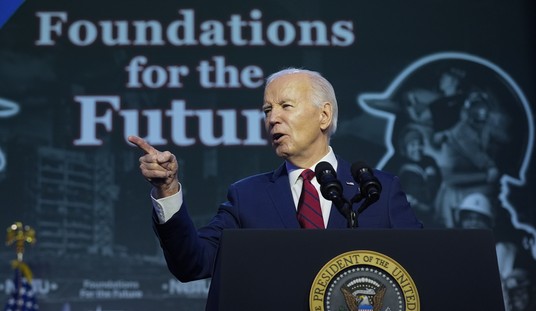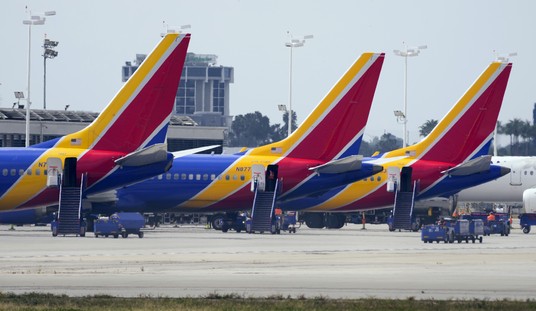
This image made from video of an Aug. 14, 2017, still image broadcast in a news bulletin on Tuesday, Aug. 15, 2017, by North Korea’s KRT shows North Korean leader Kim Jong Un receiving a briefing in Pyongyang. North Korea said leader Kim Jong Un was briefed on his military’s plans to launch missiles in waters near Guam days after the Korean People’s Army announced its preparing to create “enveloping fire” near the U.S. military hub in the Pacific. Independent journalists were not given access to cover the event depicted in this photo. (KRT via AP Video)
Shortly after midnight, Korea time, North Korea fired a single missile. That broke a 70-plus day period with no launches. This is a fairly standard pattern for North Korean launches and nothing should be read into it.
Updated quarterly data on North Korea's missile tests. Missile tests this time of year are not unprecedented, just unusual. This slowdown is probably seasonal rather than strategic. pic.twitter.com/nkaF8cYcah
— Shea Cotton (@Shea_Cotton) November 28, 2017
The average number of launches for the fourth quarter is “one” and despite some claims, this is not the most active launch year on record. Last year 24 missiles were fired by North Korea.
The launch was expected.
Pentagon continues to watch North Korea 'very closely' https://t.co/l9vqtOFAjs h/t @EdwardHBOh
— NorthKoreaRealTime (@BuckTurgidson79) November 27, 2017
Seoul and allies on keep close eye on #NorthKorea missile launchhttps://t.co/zWengIDlTT
— The Korea Herald (@TheKoreaHerald) November 28, 2017
#BREAKING: #DPRK #NorthKorea soldiers and scientists operated radar equipment used to track missile trajectories on Monday, while communications within their missile base showed an unusual spike suggesting a possible ballistic missile launch on the horizon.
— ELINT News (@ELINTNews) November 28, 2017
And the US has had the E-8 JSTARS reconnaissance aircraft and the RC-135 Cobra Ball ballistic missile tracking aircraft on station since late last week.
Cobra Ball airborne – Ballistic Missile detection platform. No position showing.
🇺🇸 US Air Force RC135S 61-2662 pic.twitter.com/C5Q9s3dKV7
— CivMilAir ✈ (@CivMilAir) November 28, 2017
LIVE: Tracking over South Korea –
🇺🇸 US Air Force
E-8C Joint STARS
99-0006 RONIN32🇰🇷 Republic of Korea Air Force
E737 Peace Eye 64-700 pic.twitter.com/sRnGiunouy— CivMilAir ✈ (@CivMilAir) November 28, 2017
This is the official announcement:
The U.S. Department of Defense detected and tracked a single North Korea missile launch today at about 1:17 p.m. EST. Initial assessment indicates that this missile was an intercontinental ballistic missile (ICBM).
The missile was launched from Sain Ni, North Korea, and traveled about 1000 km before splashing down in the Sea of Japan, within Japan’s Exclusive Economic Zone (EEZ). We are working with our interagency partners on a more detailed assessment of the launch.
Today's DPRK Missile test, launched out of Pyongsong and according to these numbers: https://t.co/1iTF0qfAnJ
Note: impact location, acceleration, speed, etc. are all notional and for demonstrative purposes only. dat apogee doe pic.twitter.com/2Imcp7BLQm
— Scott LaFoy (@wslafoy) November 28, 2017
And South Korea was ready with a counter-demonstration:
North Korea fires a missile for the first time in more than two months. South Korea's military stages 'precision strike' missile exercise in response. Developing story here: https://t.co/Y8zxdI1TQK pic.twitter.com/eI9d4ELdT4
— Anna Fifield (@annafifield) November 28, 2017
MORE: Pres. Trump was briefed on North Korea while missile was still in the air, Press Sec. Sanders says. https://t.co/3S8l7oenTB pic.twitter.com/hg9vQhtPVw
— ABC News (@ABC) November 28, 2017
This is what we think we know at this point. Cue the mood music:
Initial US assessment: North Korea missile was an ICBM. It reached an altitude of 4,500km (about 2,800 miles). For context, International Space Station orbits at 408km (253 miles). This is significantly higher than NK’s July 28 ICBM launch (3,700km altitude). It landed off Japan.
— Will Ripley (@willripleyCNN) November 28, 2017
Launching due north with the same Earth-relative velocity and with elevation only 20 to 30 deg instead of 82 deg, I get about 9500 km. YMMV
— Jonathan McDowell (@planet4589) November 28, 2017
This from Union of Concerned Scientists, which are hardly honest brokers on the issue of nuclear weapons but they are what they are:
If these numbers are correct, then if flown on a standard trajectory rather than this lofted trajectory, this missile would have a range of more than 13,000 km (8,100 miles). This is significantly longer than North Korea’s previous long range tests, which flew on lofted trajectories for 37 minutes (July 4) and 47 minutes (July 28). Such a missile would have more than enough range to reach Washington, DC, and in fact any part of the continental United States.
Early numbers, but new estimated range covers all of US. 10,000km (yellow) 13,000km (red) from Rason, #DPRK. https://t.co/1WhUy9L9qE pic.twitter.com/E1yoM7YdJq
— Melissa Hanham (@mhanham) November 28, 2017
And then this:
WH just canceled the WH briefing. Trump to talk at 3p instead to the pool… not the full press corps.
— Jim Acosta (@Acosta) November 28, 2017
Oops.
WH update– apparently Trump's comments are not on North Korea, but…. tax reform. There was internal confusion among aides.
— Blair Guild (@BlairGuild) November 28, 2017
Key takeaways:
1. The test is nothing extraordinary in terms of timing. It is well within the range of average in regards to winter missile tests.
2. The missile was an ICBM.
3. Despite early reports, only one, not three, missiles were fired and it was not fired from a submarine.
4. The calculated range of the missile places the entire United States within range of a future North Korean nuclear weapon.
5. There is no word as of yet on if a reentry vehicle was tested or how it performed.
As I’ve said before, what North Korea is doing right now is trying to fix engineering and manufacturing problems with its ballistic missiles. And they will eventually do that.













Join the conversation as a VIP Member